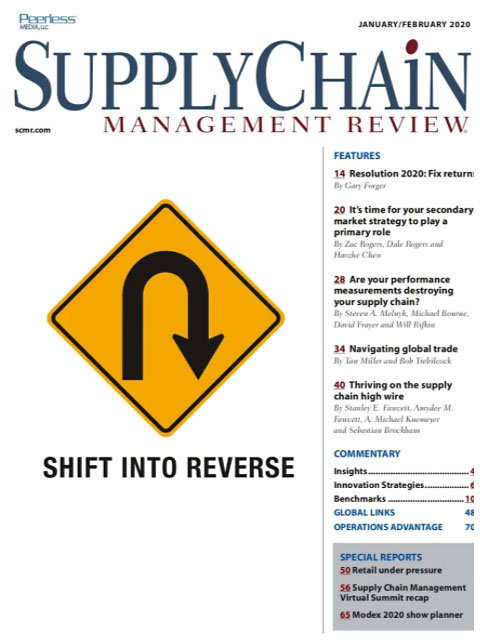Sorry, but your login has failed. Please recheck your login information and resubmit. If your subscription has expired, renew here.
January-February 2020
If the holidays at your household were like most, the gifts were chosen and wrapped with care, and then half were returned in the week after Christmas. Maybe more than half. After all, who among us hasn’t bought four shirts in a variety of sizes and colors with the intent of keeping one and returning three. And why not: Retailers and e-tailers alike have made returns seamless, easy and cheap. At least for the shopper. For the supply chains of the retailer, manufacturer or brand owner, returns are a once-neglected area that is growing into a major focus of supply chain managers who don’t want to see their organizations lose their shirt taking… Browse this issue archive.Need Help? Contact customer service 847-559-7581 More options
I was a survivor of the Arab Oil embargo in October 1973, when the members of the Organization of Arab Petroleum Exporting Countries (OPEC) proclaimed an oil embargo against nations perceived as supporting Israel. It lasted about six months and resulted in an oil crisis, with prices rising and sporadic shortages of gasoline. I was a student and living off campus. Gas was rationed so that you could only buy gas on even days or odd days, depending on the last digit of your license plate. I panicked because my tank was virtually running on fumes each time I went to get gas, wary that nearby stations might be out of it. Since those days, I’ve tried to be as energy efficient as possible, especially realizing that non-renewable carbon-based energy might someday be depleted.
Thus, when I began researching oil as part of the MIT Supply Chain 2020 Project in 2005, I espoused a reduction of oil consumption in global supply chains by slowing them down and developing cost- and energy-efficient networks, in contrast to cost- and asset-efficient ones. The position was based on two major demand-supply assumptions. While oil would be readily available into the foreseeable future: 1) its price would rise in the long-run as demand for it rose with robust global economic growth; and 2) oil extraction costs would continue to rise over time because it was getting harder to extract it from the earth.
However, two years ago I noted that both assumptions no longer held. The updated analysis postulated that recent oil prices have flattened to an “era of cheaper oil.”
History of oil pricing
Each annual oil update I’ve done is reflected in Figure 1, a historical chart depicting “real” quarterly imported crude oil prices over the past 40+ years. The chart shows the various pricing levels experienced. From the demand side, the first signs of cheaper oil appeared as a precipitous drop as a result of the Great Recession, which drastically depressed worldwide economies and the demand for oil. This was followed by a three-plus year period, termed the “$100+ Plateau” before reaching cheaper oil. That plateau still ominously looms in the rearview mirror as a reminder of what could happen if worldwide economic and supply conditions reach the levels seen prior to the recession.

This complete article is available to subscribers only.
Log in now for full access or start your PLUS+ subscription for instant access.
SC
MR
Sorry, but your login has failed. Please recheck your login information and resubmit. If your subscription has expired, renew here.
January-February 2020
If the holidays at your household were like most, the gifts were chosen and wrapped with care, and then half were returned in the week after Christmas. Maybe more than half. After all, who among us hasn’t bought… Browse this issue archive. Access your online digital edition. Download a PDF file of the January-February 2020 issue.I was a survivor of the Arab Oil embargo in October 1973, when the members of the Organization of Arab Petroleum Exporting Countries (OPEC) proclaimed an oil embargo against nations perceived as supporting Israel. It lasted about six months and resulted in an oil crisis, with prices rising and sporadic shortages of gasoline. I was a student and living off campus. Gas was rationed so that you could only buy gas on even days or odd days, depending on the last digit of your license plate. I panicked because my tank was virtually running on fumes each time I went to get gas, wary that nearby stations might be out of it. Since those days, I've tried to be as energy efficient as possible, especially realizing that non-renewable carbon-based energy might someday be depleted.
Thus, when I began researching oil as part of the MIT Supply Chain 2020 Project in 2005, I espoused a reduction of oil consumption in global supply chains by slowing them down and developing cost- and energy-efficient networks, in contrast to cost- and asset-efficient ones. The position was based on two major demand-supply assumptions. While oil would be readily available into the foreseeable future: 1) its price would rise in the long-run as demand for it rose with robust global economic growth; and 2) oil extraction costs would continue to rise over time because it was getting harder to extract it from the earth.
However, two years ago I noted that both assumptions no longer held. The updated analysis postulated that recent oil prices have flattened to an “era of cheaper oil.”
History of oil pricing
Each annual oil update I've done is reflected in Figure 1, a historical chart depicting “real” quarterly imported crude oil prices over the past 40+ years. The chart shows the various pricing levels experienced. From the demand side, the first signs of cheaper oil appeared as a precipitous drop as a result of the Great Recession, which drastically depressed worldwide economies and the demand for oil. This was followed by a three-plus year period, termed the “$100+ Plateau” before reaching cheaper oil. That plateau still ominously looms in the rearview mirror as a reminder of what could happen if worldwide economic and supply conditions reach the levels seen prior to the recession.
SC
MR


Latest Supply Chain News
- Few executives believe their supply chains can respond quickly to disruptions
- Technology’s role in mending supply chain fragility after recent disruptions
- Tech investments bring revenue increases, survey finds
- Survey reveals strategies for addressing supply chain, logistics labor shortages
- Israel, Ukraine aid package to increase pressure on aerospace and defense supply chains
- More News
Latest Podcast

 Explore
Explore
Procurement & Sourcing News
- Israel, Ukraine aid package to increase pressure on aerospace and defense supply chains
- How CPG brands can deliver on supplier diversity promises
- How S&OP provides the answer to in-demand products
- There is still work to do to achieve supply chain stability
- Blooming success: The vital role of S&OE in nurturing global supply chains
- How one small part held up shipments of thousands of autos
- More Procurement & Sourcing
Latest Procurement & Sourcing Resources

Subscribe

Supply Chain Management Review delivers the best industry content.

Editors’ Picks






